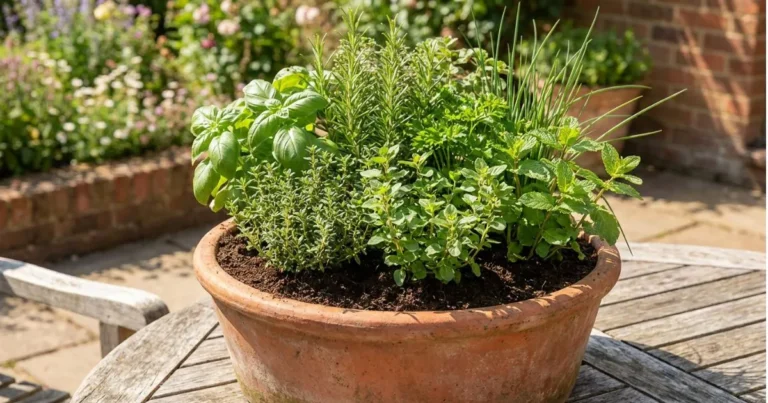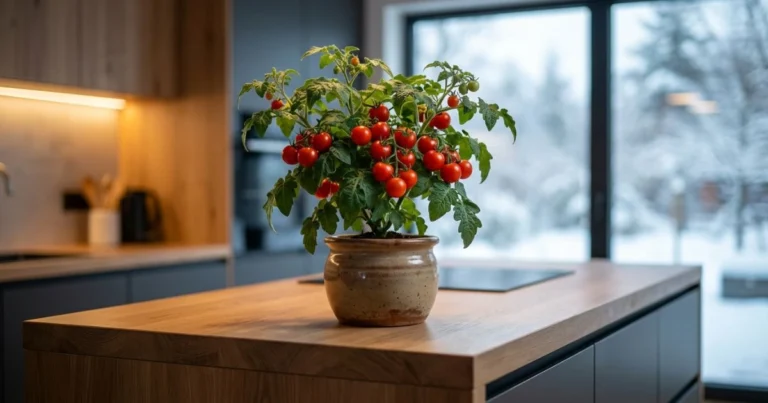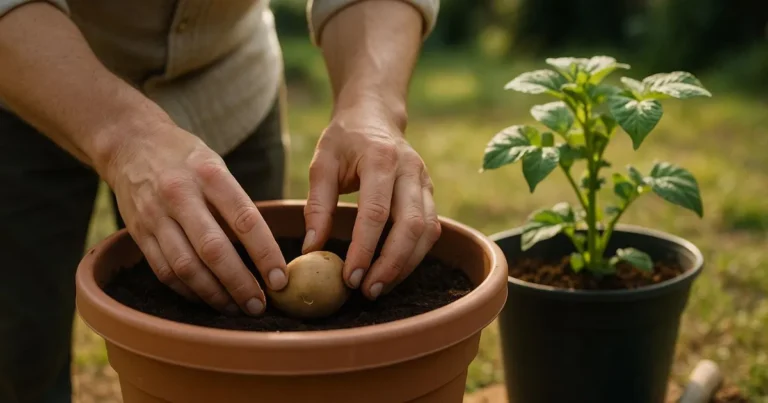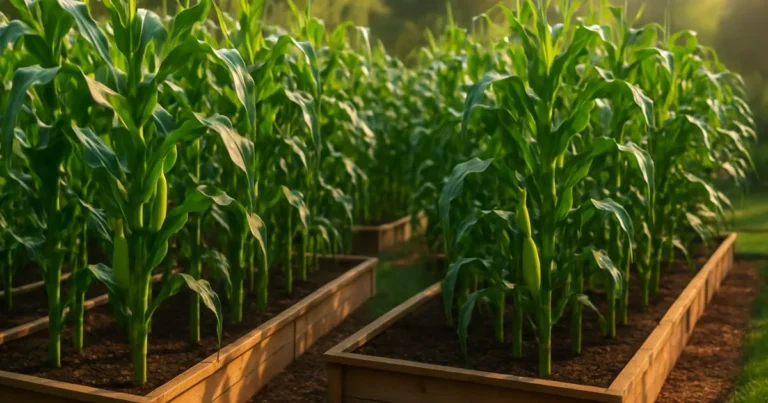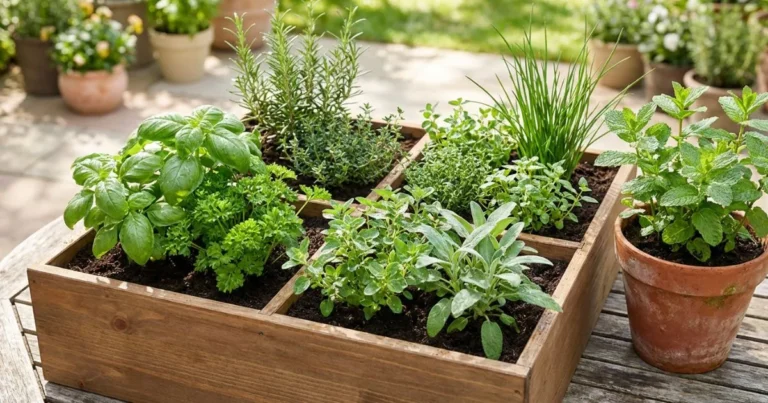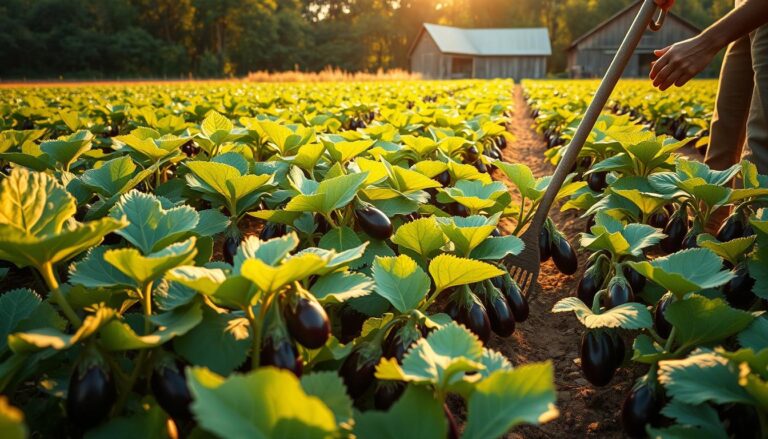Growing Corn in Containers: What You Need to Know
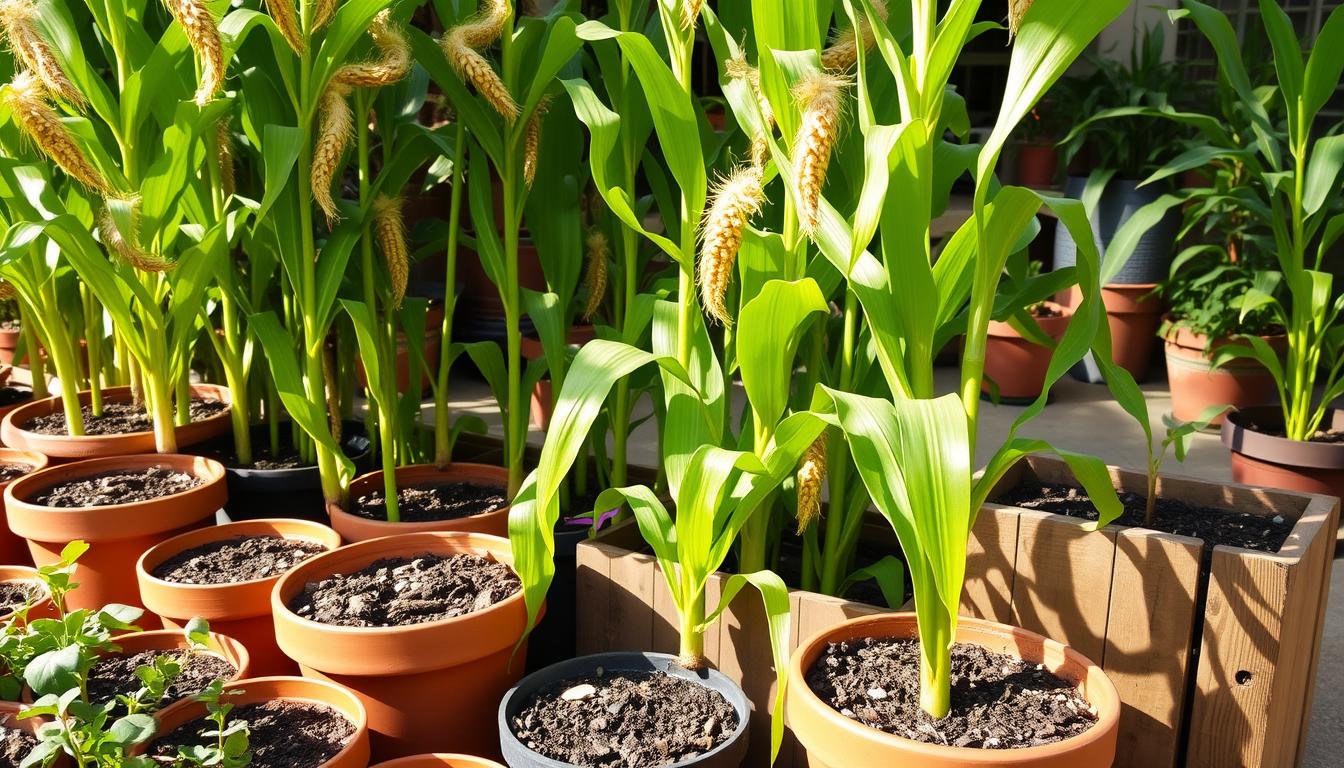
Table of Contents
Growing Corn in Containers: What You Need to Know
Imagine enjoying fresh, juicy corn from your own backyard. This is possible, even if you live in a small urban apartment.
Container gardening makes this dream come true. It’s fun and rewarding for gardeners of all ages and skill levels.
Gardening with containers lets you control the soil, moisture, and sunlight. This makes it easier to grow corn and other crops. With the right container gardening tips, you can have a successful harvest.
Whether you’re experienced or new to gardening, urban corn farming in containers is a great start. It’s a fun way to begin your gardening journey.
The Benefits of Growing Corn in Containers
Container gardening with corn has many perks. It saves space and helps control pests. This method is perfect for city gardeners with little room.
Space Efficiency for Urban Gardeners
For those in the city, growing corn in containers is a big plus. It lets you use every inch of space. Whether it’s a balcony, patio, or rooftop, you can grow corn.
Mobility and Protection from Weather Extremes
Containers let you move your corn plants around. This protects them from too much rain or sun. Moving them can keep your corn healthy and productive.
Pest and Disease Control Advantages
Container gardening helps you fight pests and diseases better. By keeping your corn in containers, you can stop diseases from spreading. It’s easier to manage pests too.
Extended Growing Season Possibilities
Containers also let you grow corn longer. You can start your plants indoors early. Then, move them outside when it’s warmer. This gives you a jumpstart on the growing season.
By using these advantages, you can have a great corn harvest. Even in small or unusual spaces, you can grow corn successfully.
Selecting the Right Containers for Corn
Choosing the right container is key to growing corn in containers. You need to think about a few things to get a healthy crop.
Container Size and Depth Requirements
Corn needs a lot of room for its roots. A container that’s at least 12 inches deep and wide is best. This size lets the roots grow and supports the tall stalks.
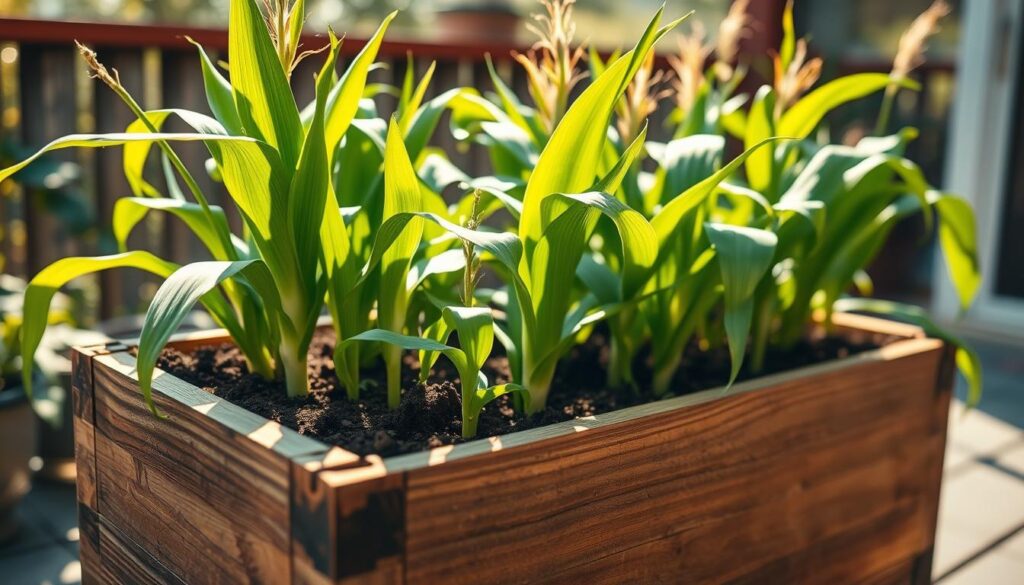
Material Considerations: Plastic vs. Fabric vs. Ceramic
The material of your container affects soil temperature and moisture. Plastic containers keep moisture in but can get too hot. Fabric containers let air in and prevent overheating. Ceramic containers look nice but are heavy and might crack.
Drainage Solutions for Healthy Root Systems
Good drainage is key to stop waterlogged soil. Make sure your container has drainage holes at the bottom. Adding small rocks or broken pottery can help with drainage too.
Positioning and Stability for Tall Plants
Corn plants can get very tall, so they need to be stable. Pick a heavy container or one you can weigh down. Place it where your corn gets enough sunlight and is safe from strong winds.
| Container Material | Moisture Retention | Aeration | Aesthetics |
|---|---|---|---|
| Plastic | High | Low | Moderate |
| Fabric | Moderate | High | Moderate |
| Ceramic | Moderate | Low | High |
Best Corn Varieties for Container Growing
Choosing the right corn for containers is key. Look for varieties that are small, productive, and fit well in tight spaces. There are many options, each with its own benefits and traits.
Compact and Dwarf Varieties for Limited Spaces
Compact and dwarf corn varieties are perfect for small spaces. They are bred to be productive in tight spots. ‘Silver Queen’ and ‘Golden Bantam’ are top picks for city gardeners.
Sweet Corn Options with Shorter Maturation Periods
Sweet corn that matures quickly is great for containers. Try ‘Early Sunglow’ or ‘Honey & Cream’, which are ready in 60 days or less. They offer a fast harvest and tasty flavor.
Container-Friendly Heirloom Varieties
Heirloom corn adds a special touch to your garden. Some are tall, but there are compact ones like ‘Stowell’s Evergreen’. They bring a rich genetic mix and are perfect for those seeking something unique.
Ornamental Corn for Dual-Purpose Growing
Ornamental corn, such as ‘Indian Summer’ or ‘Rainbow’, is great for both looks and taste. They are beautiful and delicious.
| Corn Variety | Maturation Days | Description |
|---|---|---|
| Silver Queen | 92 | Compact, white corn variety |
| Early Sunglow | 60 | Sweet corn, early maturation |
| Indian Summer | 100 | Ornamental, edible ears |
By picking the right corn for your containers, you can have a big harvest even in small spaces. Whether you want sweet corn, heirloom, or ornamental, there’s a type for you.
Soil and Fertilizer Requirements
To grow corn in containers, knowing the soil and fertilizer needs is key. The right mix of soil and fertilizers helps your corn grow well and gives you a good harvest.
Creating the Optimal Soil Mix for Containers
A good potting mix is vital for growing corn in containers. Mix together:
- Compost for nutrients
- Peat moss or coconut coir to keep moisture in
- Perlite or vermiculite for better drainage
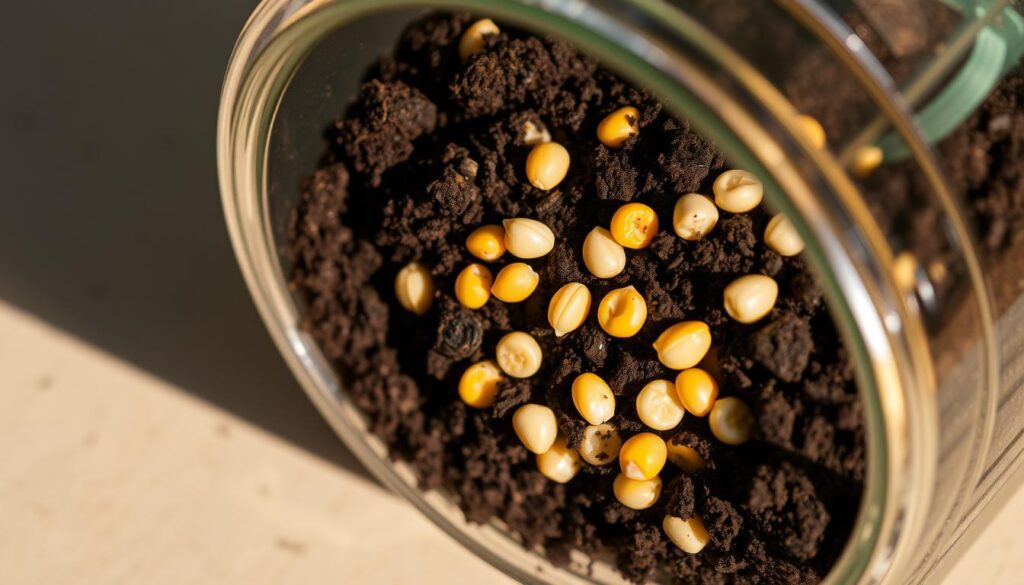
Organic vs. Synthetic Fertilizer Options
You can choose between organic or synthetic fertilizers for your corn. Organic fertilizers like compost tea or manure feed the soil slowly. Synthetic fertilizers give nutrients quickly but need more frequent use.
For growing corn indoors or outside, a balanced fertilizer (like 10-10-10 NPK) is best. Use a slow-release fertilizer to keep nutrients available all season.
Fertilization Schedule Throughout the Growing Season
Having a regular fertilization schedule is important for growing vegetables in containers. Start with a slow-release fertilizer in the soil at planting time. Then, add:
- A high-nitrogen fertilizer when plants are 12 inches tall
- A balanced fertilizer when plants start to tassel
This plan meets the corn’s nutrient needs.
pH Balancing for Maximum Nutrient Uptake
Keeping the soil pH right is key for corn plant maintenance. Corn likes a slightly acidic to neutral soil pH (around 6.0-7.0). Check your soil pH often and adjust it to help your corn absorb nutrients better.
By following these tips for soil and fertilizer, you’ll have a great container corn harvest.
The Essential Guide to Growing Corn in Containers
To grow corn in containers, you need to know about planting depth, spacing, and arrangement. You also need to manage moisture and provide enough sunlight.
Planting Depth, Spacing, and Arrangement
When planting corn in containers, depth and spacing are key. Plant seeds 1 inch deep and 6 inches apart in a 12-inch deep container. Arrange plants in a block pattern to help with pollination.
- Plant seeds 1 inch deep
- Space seeds 6 inches apart
- Use a block pattern for arrangement
Watering Techniques and Moisture Management
Keeping the soil moist is vital for healthy corn. Water when the top inch of soil feels dry. Make sure the containers drain well to avoid soggy soil.
Tips for Watering:
- Check soil moisture regularly
- Water thoroughly but avoid overwatering
- Ensure containers have good drainage holes
Sunlight Requirements and Positioning
Corn needs full sun to grow well. Place your containers in a spot that gets at least 6 hours of direct sunlight a day.
Positioning Tips:
- Choose a sunny location
- Avoid shading from other plants or structures
- Consider using reflective surfaces to enhance sunlight
Support Systems for Tall Stalks
Corn plants can grow tall and may need support. Use stakes or a trellis to keep them upright.
Support Options:
- Individual stakes for each plant
- A trellis system for multiple plants
- Container designs with built-in support
By following these tips, you can grow corn in containers successfully and enjoy a bountiful harvest.
Indoor and Outdoor Container Corn Cultivation
You can grow corn in containers in many places, like balconies and indoor spots. This makes it easy to grow corn where you have space.
Growing Corn on Balconies and Patios
Growing corn on balconies and patios is a smart use of outdoor space. Make sure your containers get enough sunlight. Also, protect them from strong winds that could harm the stalks.
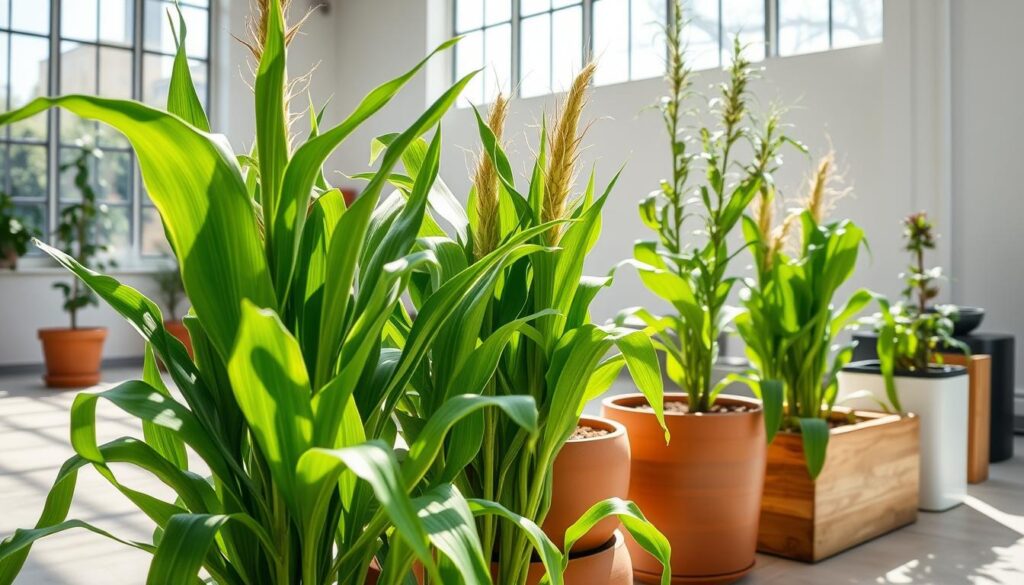
Indoor Growing with Artificial Lighting
Indoor growing needs artificial lighting to match the sun’s light. LED grow lights are good because they save energy and give the right light for plants.
Temperature and Humidity Considerations
Corn likes warm weather to grow. Indoors, keep the temperature between 65-85°F (18-30°C). Also, make sure the air is moist to avoid water stress.
Transitioning Between Indoor and Outdoor Environments
If you start corn indoors, move it outside when it’s warmer. Gradually get your plants used to outdoor conditions over 7-10 days to avoid shock.
Knowing what your container corn needs helps you grow it anywhere. Indoors or outdoors, with the right care, you can have a big harvest.
Pollination Techniques for Container Corn
To get a lot of container corn, you need to pollinate it right. Corn gets pollinated by the wind. But, it’s hard to get enough pollination when it’s in containers.
Understanding Corn’s Unique Pollination Requirements
Corn needs cross-pollination to grow ears. You need more than one corn plant to move pollen from the tassels to the silks.
Key to successful pollination: Multiple corn plants close together.
Hand Pollination Methods for Container Gardens
If natural pollination doesn’t work, you can pollinate by hand. Shake the corn stalks to get pollen out. Or, use a small, clean brush to move pollen from tassels to silks.
- Use a soft-bristled brush for pollen transfer.
- Pollinate in the morning for best results.
Optimal Timing for Successful Pollination
Pollination happens when corn is in the late whorl or early tasseling stage. Timing is key because silks can only take pollen for a short time.
Grouping Strategies to Improve Natural Pollination
Putting multiple containers together helps natural pollination. Arrange them in a block or tight cluster to boost pollination success.
For container corn care, keep your plants healthy and strong. This helps with successful pollination.
Companion Planting and Space Optimization
Growing corn in containers can be more productive with the right space use and companion planting. This method involves growing different plants together. It helps improve their growth, health, and yield.
The Three Sisters Method Adapted for Containers
The Three Sisters method is great for container gardens too. It includes corn, beans, and squash. Corn gives beans a place to climb, beans fix nitrogen, and squash keeps the soil cool and weed-free.
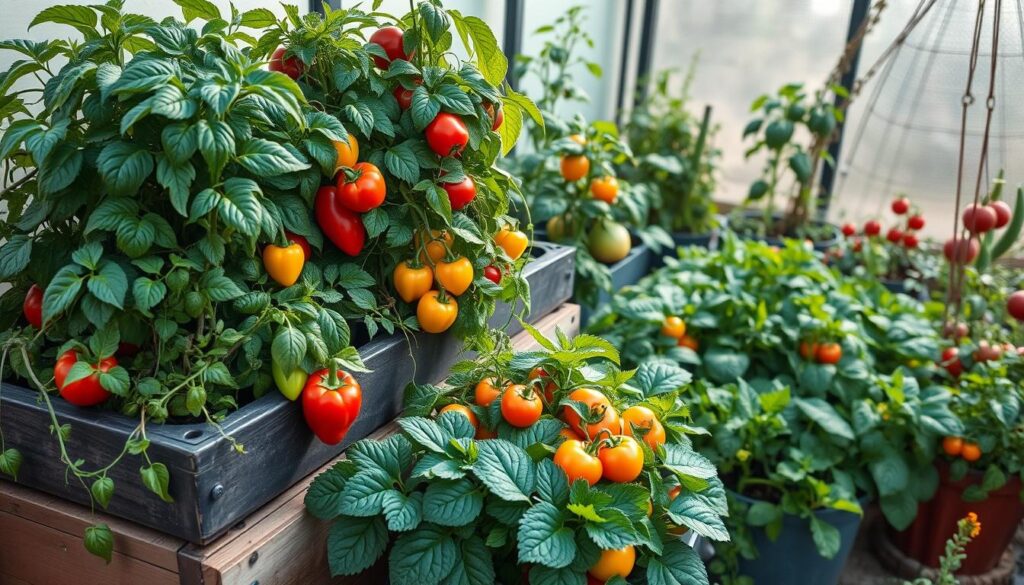
Beneficial Companion Plants for Corn
Marigolds and basil are good for corn. Marigolds keep pests away, and basil makes corn taste better and keeps aphids off.
Plants to Avoid Growing with Corn
Don’t grow tomatoes or Brassica family plants like broccoli near corn. They might compete for resources or get sick from the same diseases.
Vertical Gardening Techniques with Corn
Using vertical space can make your container garden better. Use trellises or cages for climbing plants like beans or cucumbers. This way, you use all the space in your container.
| Companion Plant | Benefit |
|---|---|
| Marigolds | Deter pests |
| Basil | Improves flavor, repels aphids |
Troubleshooting Container Corn Problems
To grow healthy corn in containers, spotting and fixing problems early is key. Container corn faces issues like slow growth, pests, and diseases.
Addressing Stunted Growth and Poor Development
Slow growth in container corn often stems from poor soil, lacking nutrients, or wrong watering. Make sure your container drains well and use a balanced fertilizer. Check the soil moisture often and adjust your watering.
Managing Pests in Container Environments
Pests like aphids, spider mites, and corn borers can harm container corn. Regularly check your plants for pests. Use natural pest control whenever you can. Keeping your containers clean helps prevent pests.
Preventing and Treating Common Corn Diseases
Diseases like rust, leaf blight, and root rot can be serious. To avoid these, ensure good air circulation and avoid watering overhead. If you see disease, remove sick leaves or stalks to stop it from spreading.
Solving Pollination and Ear Formation Issues
Poor pollination can cause bad ear formation. Container corn might need hand pollination because it lacks wind and insects. Gently shake the stalks or use a small brush to move pollen.
| Issue | Cause | Solution |
|---|---|---|
| Stunted Growth | Inadequate soil quality, insufficient nutrients | Use well-balanced fertilizer, ensure good drainage |
| Pests | Aphids, spider mites, corn borers | Regular inspection, organic pest control |
| Diseases | Rust, leaf blight, root rot | Good air circulation, avoid overhead watering |
| Poor Ear Formation | Inadequate pollination | Hand pollination using a small brush |
Conclusion
You can grow corn in containers with the right care. Follow the tips in this article for a great harvest. Even in small spaces, you can enjoy fresh corn.
Container gardening is great for saving space and protecting your plants. Choose the right containers and soil. Make sure your plants get enough sunlight and water.
Growing corn in containers has many benefits. It’s efficient with space and can move around. You can also protect your plants from harsh weather.
By picking compact corn varieties and using companion planting, your garden will thrive. With the right care, growing corn in containers can be very rewarding. You’ll have fresh corn right from your garden.
Try out different corn varieties and gardening techniques. This will help you find what works best for you. Follow the tips in this article for a successful harvest and enjoy your container gardening.

